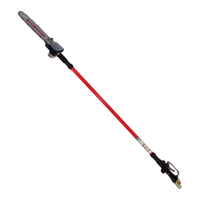8
ELECTRICAL HAZARDS
The following guidelines must be followed to prevent accidental contact with overhead electrical conductors and/or com-
munication wires and cables. (ref. ANSI Z133.1-2000)
Working in Proximity to Electrical Hazards:
An inspection shall be made by a qualifi ed arborist to determine whether an electrical hazard exists before climbing, or
otherwise entering, or performing work in or on a tree.
Only qualifi ed line-clearance arborists or qualifi ed line-clearance arborist trainees shall be assigned to work where an
electrical hazard exists. Qualifi ed line-clearance arborist trainees shall be under the direct supervision of qualifi ed line-
clearance arborist.
A second qualifi ed line-clearance arborists or line-clearance arborist trainees shall be within vision or voice communica-
tion during line-clearing operations aloft when line-clearance arborists or line-clearance arborist trainees must approach
closer than 10 feet (3.05 meters) to any energized electrical conductor in excess of 750 volts (primary conductor) or when:
(1) Branches or limbs being removed cannot fi rst be cut (with a pole pruner/pole saw) to suffi ciently clear electrical
conductors, so as to avoid contact.
(2) Roping is required to remove branches or limbs from such electrical conductors. This does not apply to indi-
viduals working on behalf of, or employed by, electrical system owners/operators engaged in line-clearing
operations incidental to their normal occupation.
Qualifi ed line-clearance arborists and line-clearance arborist trainees shall maintain minimum approach distances from
energized electrical conductors in accordance with Table 1.
All other arborists shall maintain a minimum approach distance from energized electrical conductors in accordance with
Table 2.
Branches hanging on an energized electrical conductor shall be removed using non-conductive equipment.
Table 1 - Minimum approach distances from energized conductors for qualifi ed line-clearance ar-
borists and qualifi ed line- clearance arborist trainees.
Nominal Voltage
(kV phase-to-phase)
Includes 1910.269 eleva-
tion factor, sea level to
5000 ft
1)
Includes 1910.269 eleva-
tion factor, 5001 - 10,000
ft
1)
Includes 1910.269 elevation fac-
tor, 10,000 - 14,000 ft
1)
ft-in m ft-in m ft-in m
0.05 to 1.0 Avoid contact Avoid contact Avoid contact
1.1 to 15.0 2-04 0.71 2-08 0.81 2-10 0.86
15.1 to 36.0 2-09 0.84 3-02 0.97 3-05 1.04
36.1 to 46.0 3-00 0.92 3-05 1.04 3-09 1.14
46.1 to 72.5 3-09 1.14 4-03 1.30 4-07 1.40
72.6 to 121.0 4-06 1.37 5-02 1.58 5-07 1.70
138.0 to 145.0 5-02 1.58 5-11 1.80 6-05 1.96
161.0 to 169.0 6-00 1.83 6-10 2.08 7-05 2.26
230.0 to 242.0 7-11 2.41 9-00 2.75 9-09 2.97
345.0 to 362.0 13-02 4.02 15-00 4.58 16-03 4.96
500.0 to 550.0 19-00 5.80 21-09 6.63 23-06 7.17
765.0 to 800.0 27-04 8.34 31-03 9.53 33-10 10.32
1)
Exceeds phase-to-ground; elevation factor per 29 CFR 1910.269.

